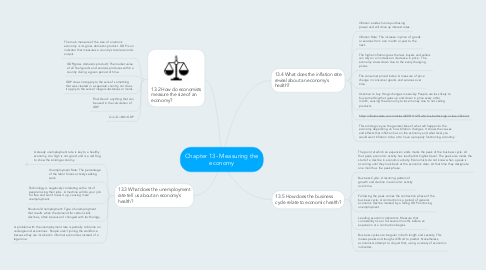Chapter 13- Measuring the economy
by Chandron McMillan

1. 13.3 What does the unemployment rate tell us about an economy's health?
1.1. A steady unemployment rate is key to a healthy economy, too high is not good and is a red flag to show the sinking economy.
1.1.1. h
1.2. Unemployment Rate: The percentage of the labor forces actively seeking work.
1.3. Technology is negatively correlating with a lot of people losing their jobs. A machine will do your job for free and won't mess it up, causing more unemployment.
1.4. Structural Unemployment: Type of unemployment that results when the demand for certain skills declines, often because of changed with technology.
1.5. A problem with the unemployment rate is partially to blame on underground economies. People aren't joining the workforce because they are involved in informal economies instead of a legal one.
2. 13.2 How do economists measure the size of an economy?
2.1. The main measure of the size of a nation's economy is its gross domestic product. GDP is an indicator that measures a country's total economic output.
2.2. GDP(gross domestic product): The market value of all final goods and services produces within a country during a given period of time.
2.3. GDP does not apply to the sale of something that was created in a separate country, nor does it apply to the sale of illegal substances or items.
2.4. Final Good: anything that can be used in the calculation of GDP.
2.5. C+I+G+NX=GDP
3. 13.5 How does the business cycle relate to economic health?
3.1. The point at which an expansion ends marks the peak of the business cycle. At that peak, economic activity has reached its highest level. The peak also marks the start of a decline in economic activity. Economists do not know when a peak is occurring until they look back at the economic data. At that time they designate one month as the peak phase.
3.2. Business Cycle: A recurring pattern of growth and decline in economic activity over time.
3.3. Following the peak comes the contraction phase of the business cycle. A contraction is a period of general economic decline marked by a falling GDP and rising unemployment.
3.4. Leading economic indicators: Measure that consistently rise or fall several months before an expansion or a contraction begins
3.5. Business cycles are irregular in both length and severity. This makes peaks and troughs difficult to predict. Nonetheless, economists attempt to do just that, using a variety of economic indicators.
4. 13.4 What does the inflation rate reveal about an economy's health?
4.1. Inflation erodes future purchasing power and will drive up interest rates.
4.2. Inflation Rate: The increase in price of goods or services from one month or year to the next.
4.3. The higher inflation goes the less buyers and sellers can rely on an increase or decrease in price. The economy slows down due to the every changing prices.
4.4. The consumer priced index: A measure of price change in consumer goods and services over time.
4.5. Incentive to buy things changes massively. People are less likely to buy something that goes up and down in price every other month, causing the economy to lose money due to not selling products.
4.6. http://inflationdata.com/articles/2009/11/25/which-is-better-high-or-low-inflation/
4.7. This article give you the general idea of what will happen to the economy depending on how inflation changes. It shows the causes and effects that inflation has on the economy and what level you would want inflation to be at to have a properly functioning economy.


